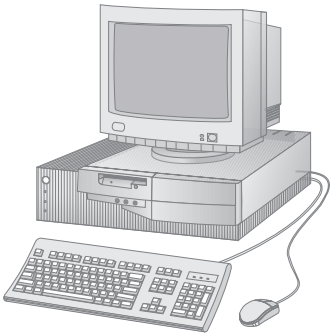IBM 300PL/GL Information and Software
System Type: 6862, 6892 / 6275, 6285

Probably the most common model of PC 300. These models contained the Pentium 2 'slot' CPUs and removed some features that the Pentium 1 based 300PLs had.
Drivers and Downloads
--> Installing Options in Your Personal Computer
--> Using Your Personal Computer
Hardware Specifications
These 300PLs feature a socket 7 Pentium MMX processor and the Triton II chipset. A very high-end chipset at the time aimed for businesses and the professional market. Here's a quick excerpt taken from the manual regarding the chipset:
PC 300PL computers use the second-generation Intel 82430HX chip set, which consists of two modules. The 324-pin TXC module provides a bridge between the PCI bus and the microprocessor bus. (For information on the PCI bus, see "PCI-to-ISA Bridge" on page 8.) The TXC module also controls the cache and system memory interfaces.
The 208-pin, PIIX3 module provides a bridge between the PCI and ISA buses. The module, which is fully compliant with PCI Local Bus Specification (Version 2.1), also contains the IDE and USB controllers.
The system memory interface in PC 300PL computers is controlled by the Intel TXC chip set module.
(Refer to "Chip Set Control" on page 6 for information on the TXC module.) There are three dual inline memory module (DIMM) sockets on the system board. The DIMM sockets are powered by +3.3 volts. This voltage allows for low-power operation and supports 64-Mbit technology. For DIMM socket pin assignments, refer to "System Memory Connectors" on page 43.
The system board supports:
* A total of 384 MB of system memory
* A maximum of 128 MB of system memory in each DIMM socket
Any configuration of DIMMs is acceptable. However, DIMMs must have the following characteristics:
* Must be EDO nonparity (NP) or EDO error correcting code (ECC) DRAMs
* Must be 16, 32, 64, or 128 MB in size
* Must be 168-pin, unbuffered, +3 V, serial PD type
* Must have gold-lead tabs
* Must have 60 ns access speed only
Also, note the following:
* EDO NP modules and EDO ECC modules can be mixed, but they will configure as NP.
* To enable ECC, all installed memory must be of the EDO ECC type.
Note: Single inline memory modules (SIMMs) are not supported in PC 300PL computers.
Triton II attempted to fix up disadvantages of the Triton I chipset... the Triton II actually did this pretty well and supports 512 MB of RAM! Very good for 1997. However, IBM only put three RAM slots, so a total of 384 MB only physically possible. Even worse, IBM didn't use an 11-bit cache tag, so these systems will take a huge performance penalty as the memory exceeds past 64MB.
In regards to the power button, it's an early version of "soft power", where the power is controlled by software. This revision of soft power allows you to crash the machine without having to hold the power button down, but also will turn itself off automatically when an OS tells it to do so. Later 300PLs after the Pentium 1 models implemented the common soft power we know today: where you must hold the power down for a few seconds before the machine can be crashed.
The internal IDE controller is limited to addressing a maximum of 8GB of space: if you need to go beyond that, you will have to use a PCI controller. The fastest processor available to the machine is a 233Mhz Pentium 1; although when inverting the DIP switches for the 233 mode, throws it into 50Mhz. So it may be possible to modify the clock speed in that undocumented mode.
300PL Fan Assembly Mod
All 300PLs sharing the 6562 case use a drop in fan assembly (which contains the LEDs and other things). It is possible to pull out the 92mm Nidec fan, cut off the wires, and solder on a 3-pin fan connector. Then you can put in any desired 92mm fan you like (probably best to use the quietest one possible). This is especially useful if the fan on your assembly has been ran to death where the point the fan is emitting irritating sounds.
